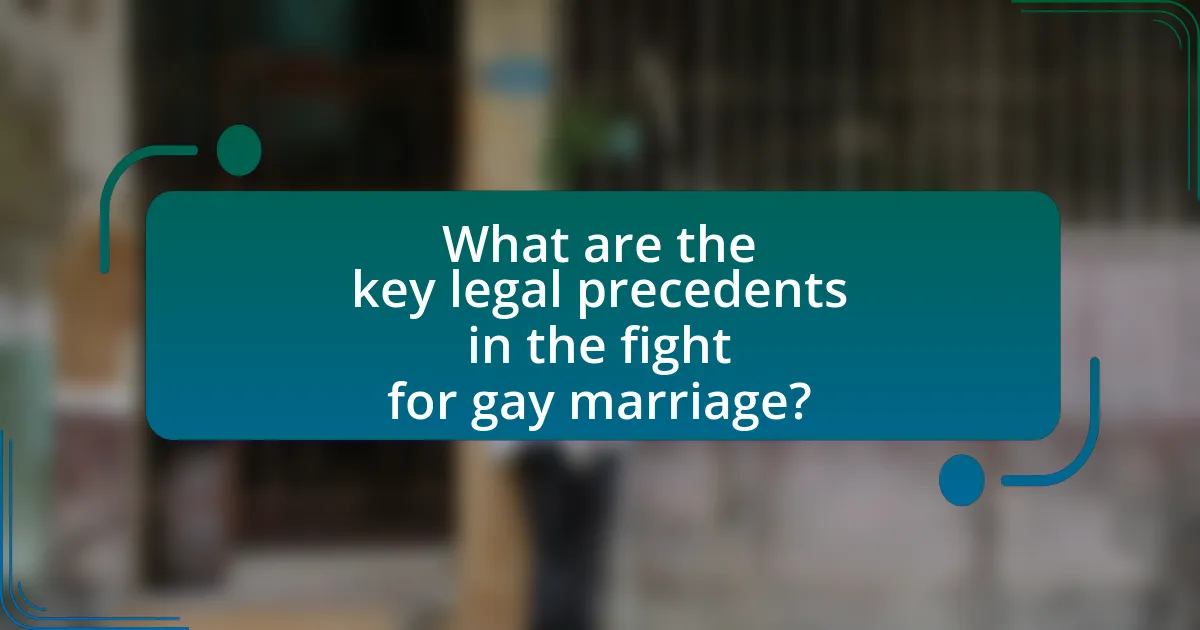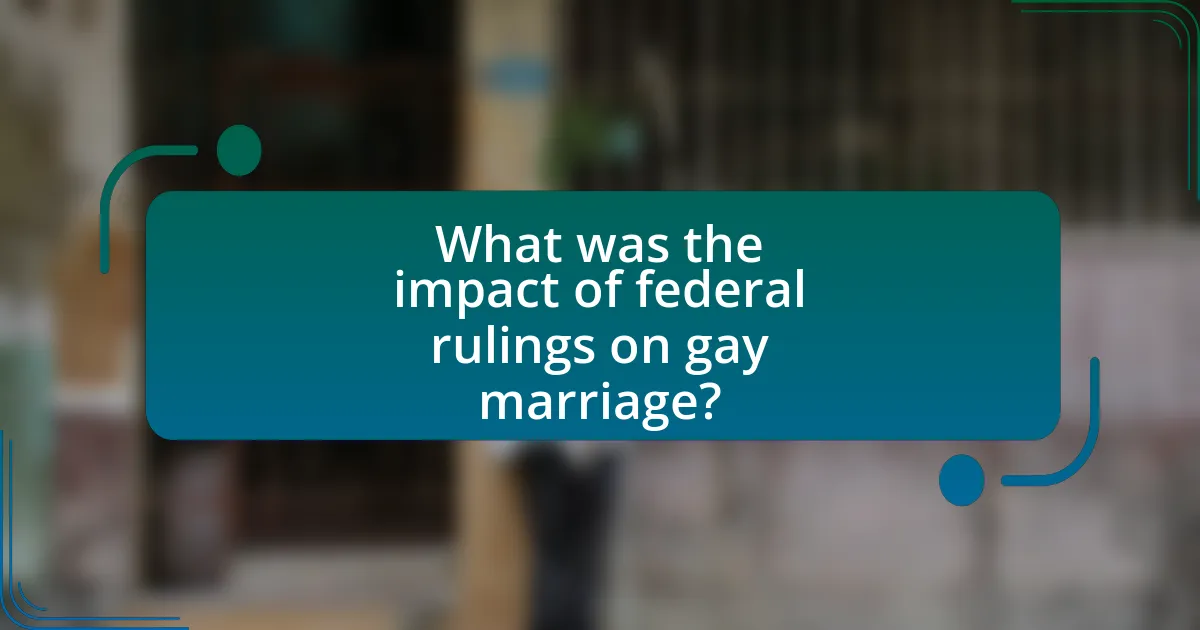The article focuses on key legal precedents in the fight for gay marriage, highlighting landmark Supreme Court cases such as Obergefell v. Hodges (2015), United States v. Windsor (2013), and Lawrence v. Texas (2003). It discusses how early cases like Baker v. Nelson and Baehr v. Lewin shaped the legal landscape and public perception of same-sex marriage. The article also examines the impact of state-level rulings, the significance of the Defense of Marriage Act (DOMA), and ongoing legal challenges that continue to affect LGBTQ+ rights. Additionally, it explores the broader implications of these legal decisions on future legislation and advocacy efforts for LGBTQ+ rights.

What are the key legal precedents in the fight for gay marriage?
The key legal precedents in the fight for gay marriage include the Supreme Court cases of Obergefell v. Hodges (2015), United States v. Windsor (2013), and Lawrence v. Texas (2003). Obergefell v. Hodges established the constitutional right to same-sex marriage nationwide, ruling that state bans on same-sex marriage violated the Fourteenth Amendment’s Equal Protection and Due Process Clauses. United States v. Windsor struck down the Defense of Marriage Act (DOMA), which denied federal recognition of same-sex marriages, affirming that such discrimination was unconstitutional. Lawrence v. Texas decriminalized same-sex sexual conduct, laying the groundwork for later marriage equality decisions by affirming the dignity and autonomy of same-sex couples. These cases collectively advanced the legal recognition and rights of same-sex couples in the United States.
How did early cases shape the legal landscape for gay marriage?
Early cases significantly shaped the legal landscape for gay marriage by establishing foundational precedents that challenged discriminatory laws. Landmark rulings, such as Baker v. Nelson in 1971, set the stage for future litigation by affirming the right to marry as a fundamental liberty, despite ultimately being dismissed by the U.S. Supreme Court. Additionally, cases like Goodridge v. Department of Public Health in 2003 in Massachusetts recognized same-sex marriage as a constitutional right, leading to the first legal same-sex marriages in the U.S. These early decisions influenced public opinion and legal arguments, paving the way for the eventual Supreme Court ruling in Obergefell v. Hodges in 2015, which legalized same-sex marriage nationwide.
What was the significance of Baker v. Nelson in 1971?
Baker v. Nelson in 1971 was significant as it marked one of the earliest legal challenges to same-sex marriage in the United States. The Minnesota Supreme Court ruled that the state had no obligation to issue marriage licenses to same-sex couples, thereby reinforcing the legal definition of marriage as a union between one man and one woman. This decision set a precedent that influenced subsequent cases and highlighted the legal barriers faced by same-sex couples, ultimately contributing to the broader discourse on marriage equality in the following decades.
How did the case of Baehr v. Lewin influence public perception?
The case of Baehr v. Lewin significantly influenced public perception by bringing national attention to the issue of same-sex marriage in the early 1990s. This landmark case, decided in 1993 by the Hawaii Supreme Court, ruled that denying marriage licenses to same-sex couples could be subject to strict scrutiny under the state constitution, thereby challenging existing legal norms. The ruling sparked widespread media coverage and public discourse, leading to increased visibility and support for LGBTQ+ rights. As a result, Baehr v. Lewin played a crucial role in shifting societal attitudes towards acceptance of same-sex marriage, ultimately contributing to the broader movement that culminated in the legalization of same-sex marriage across the United States in 2015.
What role did state-level rulings play in advancing gay marriage rights?
State-level rulings significantly advanced gay marriage rights by establishing legal precedents that challenged existing marriage laws. For instance, in 2003, the Massachusetts Supreme Judicial Court ruled in Goodridge v. Department of Public Health that denying same-sex couples the right to marry violated the state constitution, making Massachusetts the first state to legalize gay marriage. This ruling set a precedent that influenced other states and contributed to a growing national dialogue on marriage equality. Additionally, subsequent rulings in states like California and New Jersey further propelled the movement by affirming the rights of same-sex couples, ultimately leading to increased public support and paving the way for the landmark Supreme Court decision in Obergefell v. Hodges in 2015, which legalized same-sex marriage nationwide.
Which states were pioneers in legalizing gay marriage through court decisions?
Massachusetts was the first state to legalize gay marriage through a court decision, with the Massachusetts Supreme Judicial Court ruling in 2003 that denying marriage licenses to same-sex couples was unconstitutional. Following Massachusetts, other states such as California, Connecticut, Iowa, and Vermont also legalized gay marriage through court decisions, contributing to the broader movement for marriage equality across the United States.
How did the Massachusetts Supreme Judicial Court’s ruling in Goodridge v. Department of Public Health impact other states?
The Massachusetts Supreme Judicial Court’s ruling in Goodridge v. Department of Public Health set a legal precedent that influenced other states to reconsider their laws regarding same-sex marriage. This landmark decision, issued in 2003, declared that denying marriage licenses to same-sex couples violated the Massachusetts Constitution, thereby legalizing same-sex marriage in the state. Following this ruling, several states began to challenge their own marriage laws, leading to a wave of legal actions and legislative changes across the country. By 2015, the U.S. Supreme Court’s decision in Obergefell v. Hodges, which legalized same-sex marriage nationwide, was significantly informed by the arguments and legal reasoning established in Goodridge.

What was the impact of federal rulings on gay marriage?
Federal rulings significantly advanced the legalization and recognition of gay marriage in the United States. The landmark Supreme Court decision in Obergefell v. Hodges (2015) established that same-sex couples have the constitutional right to marry, thereby invalidating state bans on gay marriage. This ruling not only legalized gay marriage nationwide but also reinforced the principle of equal protection under the law, ensuring that same-sex couples receive the same legal benefits and recognition as heterosexual couples. Prior federal rulings, such as United States v. Windsor (2013), which struck down the Defense of Marriage Act, laid the groundwork for this progress by affirming that the federal government could not deny federal benefits to legally married same-sex couples. These decisions collectively transformed the legal landscape for LGBTQ+ rights, promoting greater societal acceptance and equality.
How did the Defense of Marriage Act (DOMA) affect gay marriage rights?
The Defense of Marriage Act (DOMA) significantly restricted gay marriage rights by defining marriage at the federal level as a union exclusively between one man and one woman. This law, enacted in 1996, prevented federal recognition of same-sex marriages, thereby denying same-sex couples access to over 1,000 federal benefits and protections available to heterosexual couples. The impact of DOMA was profound, as it not only invalidated state-level legalizations of same-sex marriage for federal purposes but also influenced public perception and state legislation regarding marriage equality. The law was ultimately ruled unconstitutional by the Supreme Court in 2013 in United States v. Windsor, which paved the way for broader recognition of gay marriage rights across the United States.
What were the implications of United States v. Windsor in 2013?
The implications of United States v. Windsor in 2013 were significant for the legal recognition of same-sex marriage in the United States. The Supreme Court’s decision struck down Section 3 of the Defense of Marriage Act (DOMA), which had defined marriage as a union between one man and one woman for federal purposes. This ruling allowed same-sex couples to receive federal benefits and protections previously denied to them, thereby affirming their legal status and rights. The decision also set a precedent that contributed to the momentum for further legalization of same-sex marriage across various states, ultimately leading to the landmark ruling in Obergefell v. Hodges in 2015, which legalized same-sex marriage nationwide.
How did Obergefell v. Hodges change the legal status of gay marriage in the U.S.?
Obergefell v. Hodges established that same-sex marriage is a constitutional right under the Fourteenth Amendment, effectively legalizing gay marriage across the United States. The Supreme Court’s decision on June 26, 2015, ruled that states must grant marriage licenses to same-sex couples and recognize those marriages performed in other jurisdictions. This landmark ruling was based on the principles of equal protection and due process, affirming that denying same-sex couples the right to marry violated their constitutional rights. The case consolidated several lawsuits challenging state bans on same-sex marriage, leading to a unanimous decision that fundamentally changed the legal landscape for marriage equality in the U.S.
What are the ongoing legal challenges related to gay marriage?
Ongoing legal challenges related to gay marriage primarily involve cases contesting the rights of same-sex couples in various states, particularly regarding issues like adoption, healthcare benefits, and religious exemptions. For instance, some states have enacted laws that allow businesses and individuals to refuse services to same-sex couples based on religious beliefs, leading to lawsuits that challenge the constitutionality of such laws. Additionally, cases are emerging that question the recognition of same-sex marriages performed in other jurisdictions, particularly in states that have not legalized gay marriage. These challenges are often rooted in interpretations of the First Amendment and the Equal Protection Clause of the Fourteenth Amendment, as seen in cases like Obergefell v. Hodges, which established the right to marry for same-sex couples in 2015.
What recent cases have emerged that could affect the future of gay marriage rights?
Recent cases that could affect the future of gay marriage rights include the Supreme Court’s consideration of cases related to religious exemptions and discrimination against LGBTQ+ individuals. For instance, the case of 303 Creative LLC v. Elenis, which addresses whether a business can refuse services for same-sex weddings based on religious beliefs, could set a precedent impacting the legal landscape for gay marriage rights. Additionally, the ongoing challenges to state laws that restrict or undermine marriage equality, such as those seen in various circuit courts, further highlight the evolving legal context surrounding gay marriage. These cases collectively underscore the potential for significant shifts in the interpretation and enforcement of marriage rights for same-sex couples.
How do state laws continue to challenge federal rulings on gay marriage?
State laws challenge federal rulings on gay marriage by enacting legislation that restricts or undermines the recognition of same-sex marriages. For instance, some states have passed laws that define marriage strictly as a union between one man and one woman, directly opposing the Supreme Court’s 2015 ruling in Obergefell v. Hodges, which legalized same-sex marriage nationwide. Additionally, states may refuse to issue marriage licenses to same-sex couples or may not recognize marriages performed in other states, creating a patchwork of legal recognition that contradicts federal mandates. This ongoing tension illustrates the complexities of federalism, where state laws can create significant barriers to the implementation of federal rulings.

What are the broader implications of these legal precedents?
The broader implications of legal precedents in the fight for gay marriage include the establishment of fundamental rights for same-sex couples, which influence legislation and societal norms. These precedents, such as the U.S. Supreme Court’s decision in Obergefell v. Hodges (2015), affirm that marriage is a constitutional right regardless of sexual orientation, thereby promoting equality and non-discrimination. This legal recognition not only impacts individual rights but also sets a framework for future cases related to LGBTQ+ rights, influencing public policy and encouraging similar movements globally. The ruling has led to increased acceptance and visibility of LGBTQ+ individuals, contributing to a shift in cultural attitudes towards marriage equality.
How have these legal battles influenced LGBTQ+ rights beyond marriage?
Legal battles for marriage equality have significantly advanced LGBTQ+ rights beyond marriage by establishing precedents that protect against discrimination and promote equal treatment in various areas. For instance, the Supreme Court’s decision in Obergefell v. Hodges (2015) not only legalized same-sex marriage but also reinforced the principle that LGBTQ+ individuals are entitled to equal protection under the law, influencing subsequent rulings related to employment discrimination, such as Bostock v. Clayton County (2020), which ruled that firing someone for being gay or transgender constitutes sex discrimination under Title VII of the Civil Rights Act. This legal framework has empowered advocacy for broader anti-discrimination laws, healthcare access, and protections in public accommodations, thereby expanding the scope of rights and protections for LGBTQ+ individuals across multiple facets of life.
What lessons can be learned from the fight for gay marriage that apply to other civil rights movements?
The fight for gay marriage teaches that strategic legal challenges, grassroots mobilization, and coalition-building are essential for advancing civil rights. Legal victories, such as the Supreme Court’s decision in Obergefell v. Hodges (2015), which legalized same-sex marriage nationwide, demonstrate the importance of establishing clear legal precedents that can be cited in other civil rights contexts. Grassroots efforts, including public demonstrations and advocacy campaigns, mobilized public support and shifted societal attitudes, showing that public opinion can influence legal outcomes. Additionally, forming coalitions with other marginalized groups can amplify voices and create a united front, as seen in the collaboration between LGBTQ+ activists and other civil rights organizations. These lessons highlight the interconnectedness of civil rights struggles and the effectiveness of a multifaceted approach in achieving equality.
How do these precedents affect current and future legislation regarding LGBTQ+ rights?
Legal precedents significantly shape current and future legislation regarding LGBTQ+ rights by establishing foundational principles that guide judicial interpretation and legislative action. For instance, the Supreme Court’s decision in Obergefell v. Hodges (2015) legalized same-sex marriage nationwide, reinforcing the notion that marriage is a fundamental right protected by the Constitution. This ruling has prompted lawmakers to consider LGBTQ+ rights more seriously, leading to the introduction of anti-discrimination laws and policies that protect LGBTQ+ individuals in various sectors, including employment and housing. Additionally, precedents like Lawrence v. Texas (2003), which decriminalized same-sex sexual activity, have created a legal environment that encourages further protections and rights for LGBTQ+ individuals, influencing both state and federal legislation. As a result, these precedents not only affirm existing rights but also pave the way for future advancements in LGBTQ+ equality.
What practical steps can advocates take to support ongoing LGBTQ+ rights?
Advocates can support ongoing LGBTQ+ rights by actively engaging in legislative advocacy to promote inclusive policies. This includes lobbying for anti-discrimination laws and supporting bills that protect LGBTQ+ individuals in areas such as employment, housing, and healthcare. For instance, the Equality Act, which aims to amend the Civil Rights Act to include sexual orientation and gender identity, exemplifies a legislative effort that advocates can rally behind. Additionally, advocates can participate in community outreach programs to educate the public about LGBTQ+ issues, thereby fostering a more inclusive society. Research shows that increased public awareness correlates with greater acceptance and support for LGBTQ+ rights, as evidenced by the 2019 Gallup poll indicating that 70% of Americans support same-sex marriage, up from 27% in 1996.
How can individuals engage in advocacy for LGBTQ+ rights at the local level?
Individuals can engage in advocacy for LGBTQ+ rights at the local level by participating in community organizations that focus on LGBTQ+ issues, attending local government meetings to voice support for inclusive policies, and organizing or joining awareness campaigns and events. Community organizations, such as local LGBTQ+ centers, often provide resources and platforms for advocacy, enabling individuals to connect with like-minded supporters and mobilize efforts for change. Additionally, attending city council or school board meetings allows individuals to directly influence local legislation and policies that affect LGBTQ+ rights. According to a 2020 report by the Human Rights Campaign, local advocacy efforts have been instrumental in advancing LGBTQ+ rights, demonstrating the impact of grassroots movements in shaping public policy.
What resources are available for those looking to understand and support LGBTQ+ legal issues?
Resources available for understanding and supporting LGBTQ+ legal issues include organizations such as the Human Rights Campaign, Lambda Legal, and the American Civil Liberties Union. These organizations provide comprehensive information on legal rights, advocacy efforts, and resources for individuals seeking to navigate LGBTQ+ legal matters. For instance, Lambda Legal offers legal assistance and educational materials specifically focused on LGBTQ+ rights, while the Human Rights Campaign provides updates on legislation and policy changes affecting the community. Additionally, academic institutions and law schools often publish research and host events that address LGBTQ+ legal issues, contributing to a broader understanding of the legal landscape.


